Quick search
CTRL+K
Quick search
CTRL+K

Salzburg is one of the Baroque architectural gems of the world, and as a traveler you can almost hear Mozart’s fantastic compositions in the streets. Everywhere in the old town you will be greeted by breathtaking buildings that clearly showcase the wealth the city has maintained throughout history.
The archbishops lived here and built impressive churches, fine castles and elegant squares, and as the top of everything, they laid out prestigious parks and built many sculptures to beautify the city. All this remains today, and with the city’s surroundings hills, you can easily enjoy Salzburg’s elegant skyline from several vantage points.
Salzburg is, for many, the equivalent of classical music and other culture, and as Mozart’s birthplace it do has a lot to offer. It all culminates with the world-famous festivals that are recurring events. At the festivities the city stands in the sign of music, and also at other times of the year you can enjoy church concerts and so on.
The Hohensalzburg Fortress is at the top of the city on a hilltop. It is like an old castle with its towers and defense walls. Hohensalzburg was also a residence, so there is a lot of different things to see and experience on a trip to there; which may be with funicular railway from the streets of the city.
Salzburg is beautifully nestled between small mountains and with the meandering run of the Salzach River through the center. It is beautiful, and it is easy to find great nature in the vicinity of the Austrian city. Immediately south of the city, the Alps rise to great heights, and you can make a day trip to German Berchtesgaden or the lovely Lake Königssee.
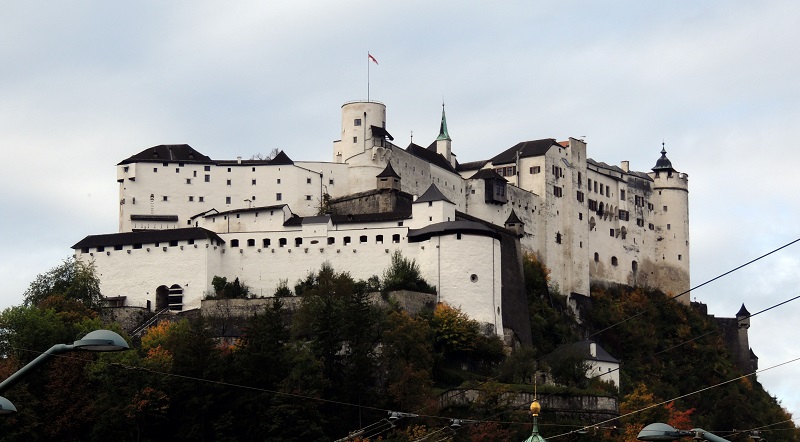
Since Salzburg’s Roman times as the provincial city of Juvavum, there have been military installations on the strategically well-located rocky outcrop on the Salzach river, where the Hohensalzburg fortress sits today.
Hohensalzburg was founded in 1077 by Archbishop Gebhard, and the first building was a very simple castle with wooden walls as defense. Over the following centuries, the building was continuously expanded, with influential Salzburg securing its political interests in the German-Roman Empire.
Among the significant extensions were the large outer walls with a castle tower, which were built in 1462 under Burkhard II. From 1495-1519, Leonhard von Keutschach ruled, and he also had the castle expanded; among other things with the so-called Reißzug, which is a cable car from around 1500. The Reißzug was built as a railway to transport goods to the castle, and it is still in operation on the east side of the castle. The Reißzug is thus probably the world’s oldest existing railway line. The track should not be confused with the passenger railway Festungsbahn, which was established in 1892. The large complex that Hohensalzburg had developed into was largely completed only in the 17th century.
Of major events in and around the castle, the only siege in history took place in 1525 during the German Peasant War, where a group of people unsuccessfully tried to depose Archbishop Matthäus Lang. In 1800, the castle was handed over to French troops in connection with the Second Coalition War, and in 1861 the castle’s military role was abandoned and played out.
After this, Hohensalzburg was arranged as a place to visit for the increasing number of tourists, and for this purpose the Funicular Festungsbahn was established in 1892. The length of the track is 191 meters with a maximum gradient of 61%. Already on the way up, you understand the fortress’s spectacular location on the Festungsberg ridge. You reach a height of 119 meters above Salzburg, and from here there is a fantastic view of the city center.
Hohensalzburg is one of Europe’s largest and best-preserved fortresses from the Middle Ages, and there are many sights here. For example, it served for many years as the residence of the archbishops, and from this time you can see the Gothic representation hall Den Gyldne Sal/Goldener Saal and suites with, not least, Det Gyldne Rum/Goldene Stube as a highlight. Both parts are elegantly decorated and were furnished around the year 1500.
In the fortress you can visit the museum Festungsmuseum, which depicts the history of the place and the life that has taken place here over the centuries. Among other things, it is furnished in some of the rooms that were already established at the end of the 11th century. You can also visit the museum Marionettenmuseum, which shows fine old marionettes and tells the story behind their use.
Otherwise, a visit to the castle is a good opportunity to explore the large complex, where you can walk outside and inside the walls and in the castle’s streets and courtyards. Here you will find, among other things, St. Jørgen Kirke/St.-Georgs-Kirche, which was built in 1501-1502.
Salzburg’s Residenz has been the residence and seat of representation of the reigning archbishops since 1120. The current building is the result of remodeling in the years 1600-1619. However, the facade was changed in 1710. In total, the Residenz consists of around 180 rooms and halls located in the building complex, the interior of which spans three inner courtyard environments. The Residenz is used today for representative purposes, and international conferences are also organized in the large complex.
Of particular interest are the Residenz’s representation rooms, the Prunkräume, which were decorated by Lukas von Hildebrandt in the period 1709-1722, and the frescoes and ceiling paintings of the place, which were executed by J. M. Rottmayr and Martino Altomonte.
Other fine rooms are the Karabinieresalen/Carabinierisaal, Kejsersalen/Kaisersaal and Riddersalen/Rittersaal, where you can see portraits of German-Roman emperors and much more. In the Residenz you will also find the art museum Residenzgallerie, whose collection contains European and Austrian visual art from the 17th-19th centuries. Among the exhibited painters are Breughel, Rembrandt and Rubens.
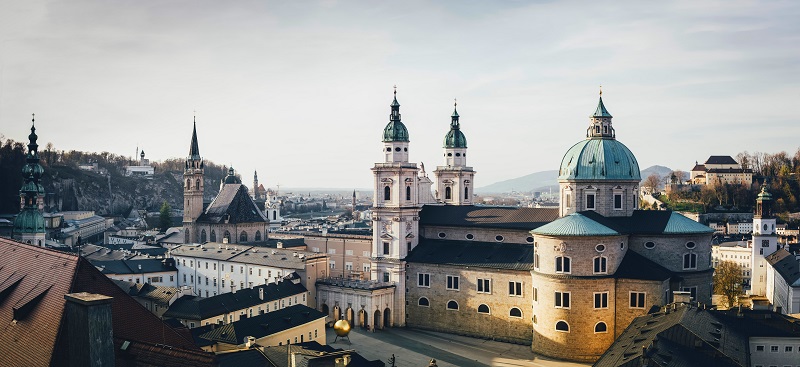
Salzburg Cathedral is a fine example of early Baroque architectural style with inspiration from Roman architecture. There have been church buildings on the site since the 7th century, and the precursor to the current building was destroyed by fire in 1598. It was just one of six fires that have ravaged the church over time.
The court architect of the time was the Italian Santino Solari, who was responsible for the new construction, which lasted from 1614 to the inauguration in 1628. The result was and is an impressive building with a ground plan of 101×69 metres. The central dome measures 79 meters in height, while the two church towers reach 81 meters. Incidentally, the towers were not completed until the 1650s. The church’s large interior provides space for as many as 10,000 churchgoers.
In connection with the construction, parts of Salzburg’s medieval town were demolished to make way for the three squares that surround the cathedral: Domplatz, Kapitelplatz and Residenzplatz. The cathedral and the three squares were part of Archbishop Wolf Dietrich’s plan to build a northern counterpart to Rome.
In front of the cathedral on the Domplatz you can see the Marian column/Mariensäule, which represents the Virgin Mary and including four allegorical figures of an angel, the Devil, wisdom and the church respectively. The meaning is that Mary’s Conception was so divine that the angels rejoiced and the Devil envious, while human wisdom was unable to explain it, and the Church celebrated the event in triumph.
The facade of the cathedral faces the square Domplatz and stands beautifully with two towers and four figures of the saints Paul, Peter, Rupert and Virgil as part of the fine decoration. The cathedral is dedicated to Saint Rupert, who established the first church on the site, and Saint Virgil, who had the first cathedral built. Among other things, marble from the nearby Untersberg was used for the church’s facade.
Inside you are greeted by a beautiful church room, where you can see, among other things, the graves of Archbishops Markus Sittikus and Paris Lodron as well as a baptismal font from 1321. Wolfgang Amadeus Mozart is among those who have been baptized in the baptismal font.
The high altar is from 1628, and the altar picture shows Christ’s ascension. Above the picture you can see statues of Saint Rupert and Saint Virgil as well as various allegories. At the top of the church you can see the beautifully decorated dome, which, among other things, features frescoes with scenes from the Old Testament. In Salzburg Cathedral, there is also a museum, the Dommuseum, which exhibits a number of different objects in beautiful, old rooms, which are worth a visit in themselves.
Getreidegasse is Salzburg’s old central shopping and commercial street. The street exudes atmosphere, and you should pay attention to the street’s many details when you walk through the street. You must remember to look up at the many craft and low signs as well as cozy entrance areas and shops. You can also see the many atmospheric farm environments found along Getreidegasse.
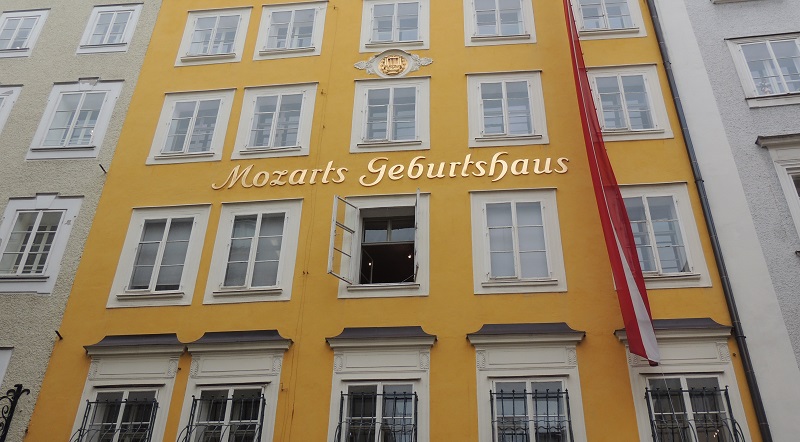
World famous Wolfgang Amadeus Mozart was born on January 27, 1756 on the third floor of this house. The family lived here until 1773, when they moved to a house at the address Hannibalplatz 8 (today Makartplatz 8).
On the occasion of Mozart’s time and history, a museum has been set up here, where several items from the composer’s life are on display. You can see, for example, letters, manuscripts and musical instruments.
Salzburg is world famous for the festivals that were started in 1920 by, among others, the composer Richard Strauss. The festivities continue, and they take place in several different buildings and locations.
This applies, for example, to the Mountain Riding School/Felsenreitschule, which is the city’s old summer riding school for the archbishops’ cavalry. The site was converted into an open-air stage for the festivities in 1926. Originally, the riding school had been built up over several centuries since its inception in 1693.
The former winter riding school, which was called Det Lille Festspilhus/Kleines Festspielhaus, was built in 1840 and rebuilt in 1926 for its current purpose. After yet another reconstruction in the years 2004-2006, the building is called the Mozart house/Haus für Mozart. During the reconstruction, the foyer area with Anton Feistauer’s frescoes from 1926 was retained. The foyer provides access to both the Haus für Mozart and the Felsenreitschule.
In 1960, the Great Festspilhus/Große Festpielhaus was built by Clemens Holzmeister. There can be more than 2,000 spectators here, and the location carved into the rock in the Mönchsberg ridge is uniquely beautiful. The Festspilhuset was inaugurated by Herbert von Karajan.
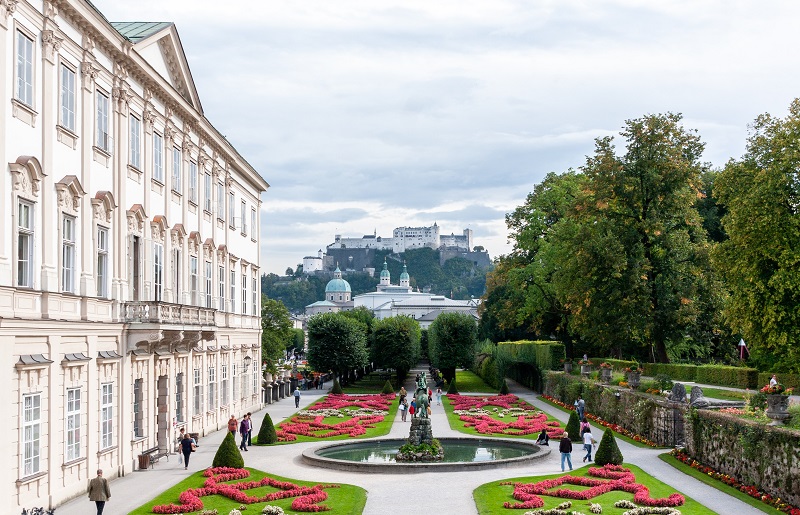
Mirabell Castle’s park was designed by Johann Fischer von Erlach in 1690 at the request of Archbishop Johann Ernst von Thun. In 1730, however, they were changed by Franz Anton Danreiter. The park was very beautifully laid out with many flower beds, fountains, lawns, statues and, on the whole, a formal garden with a view of both Mirabell Castle and Hohensalzburg Castle, which is at the end of the garden’s axis.
Dværghaven/Zwerglgarten is particularly exciting. It dates from 1715. Here you can see a series of statues of dwarfs, which were made of marble from the Untersberg southwest of Salzburg.
In front of Mirabell Castle you can see the sculpture well Pegasus. Kaspar Gras produced the winged horse in 1661, and it was erected here in 1913. In the park you will also find the garden house Zauberflötenhäuschen, the place where Wolfgang Amadeus Mozart composed The Magic Flute.
The Sebastianfriedhof cemetery is idyllically framed by colonnades behind the beautiful Sankt Sebastian Kirke/Sankt Sebastian Kirche. It was laid out in Italian style with special inspiration from Campo Santo in Pisa around the year 1600 by Andreas Berteleto.
The cemetery is where Paracelcus, the father of modern medicine, is buried. Archbishop Wolf Dietrich von Raitenau, who initiated the construction of the cemetery, is also buried here. He lies in a larger mausoleum.
One of the most visited graves is probably Wolfgang Amadeus Mozart’s wife Constanze. She is buried with her second husband, the Danish diplomat Georg von Nissen. In the cemetery you can also find many others in Mozart’s family and circle of acquaintances, while Mozart himself is buried in a mass grave in Vienna.
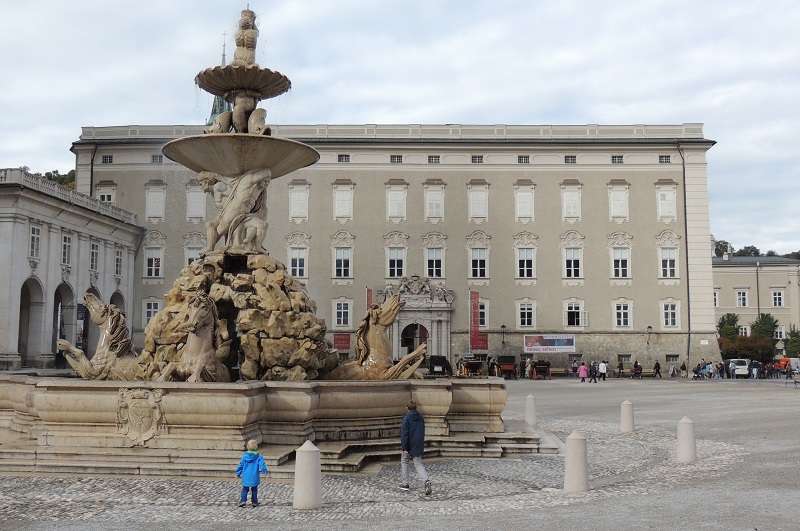
Salzburg’s distinguished Residenzplatz was created by Archbishop Wolf Dietrich from 1587. Here began the demolition of the city’s Domkirkekloster/Domkloster and 55 residential houses in the then Pfeifergasse. On the same occasion, the cathedral’s cemetery was cleared, and with that activity, space was really created for Salzburg’s transition from a medieval city to an elegant and princely residence.
On the Residenzplatz you can see the sumptuous fountain Residenzbrunnen, which was made in Baroque style 1656-1661 by Tomasso di Garona. The material is white marble that comes from the nearby Untersberg.
Around the Residenzplatz lies the side of the cathedral Salzburger Dom and the city’s two large residences; Residenz and Neue Residenz. A detail facing the square of the Neue Residenz is the tower’s carillon, the Glockenspiel, built with 35 bells from Antwerp in 1702. It plays at several times daily.
Incidentally, the only book burning took place on Residenzplatz following the German-Nazi model in the former Austria, which in 1938 became part of Germany. It took place on April 30, 1938.
The Neue Residenz is a beautiful building designed like a cornucopia of a museum. There are many different themes in the beautiful rooms and halls. 19th-century romantic painters’ impressions of the Salzburg region, archaeological finds from several millennia, great personalities from the city and remains of Roman houses are just some of the things you can choose to see.
The Neue Residenz building itself was built by the prince-bishop Wolf Dietrich von Raitenau from the year 1588. The elegant construction was intended as a residence for the bishop’s brother, but instead it became the setting for various public functions and events.
The decoration of the Neue Residenz was planned as more detailed than the result, which, despite other plans, turned out to be a beautiful whole with the castle tower as one of the crowns of the work. The top of the tower with an octagonal floor and a lantern dates from 1701-1702, when Archbishop Johann Ernst von Thun installed the residence’s fine and famous carillon, consisting of 35 bells from Antwerp.
Other decorations include a coat of arms in each corner. They come from the families of Wolf Dietrich von Raitenau’s grandparents; Hohenems, Medici, Raitenau and Sirgenstien.
Mozartplatz is one of the central squares in Salzburg’s baroque center. It was laid out in its original form in 1588 under Wolf Dietrich von Raitenau as part of the representative road to the city center. In 1620, Paris gave Lodron the building sites on the east side of Mozartplatz, which could then be completed according to plan.
Mozartplatz is dominated by the fine memorial statue of the composer Wolfgang Amadeus Mozart, who was born in the city on January 27, 1756. The statue was made by Ludwig von Schwanthaler, and it was inaugurated in 1842 with the participation of, among others, Mozart’s two sons; Carl Thomas and Franz Xaver. The monument had come into being after a major donation by King Ludwig I of Bavaria, and during its construction a Roman mosaic was found.
Buildings around the square include the Neue Residenz (Mozartplatz 1), the former noble residence of the von Rehlingen family, the Antretter Haus (Mozartplatz 4), Das Imhofstöckl (Mozartplatz 5-7) from around 1620 and the three palatial properties Kanonicalhöfe (Mozartplatz 8-10) , which were built as residences with integrated facades in the 17th century.
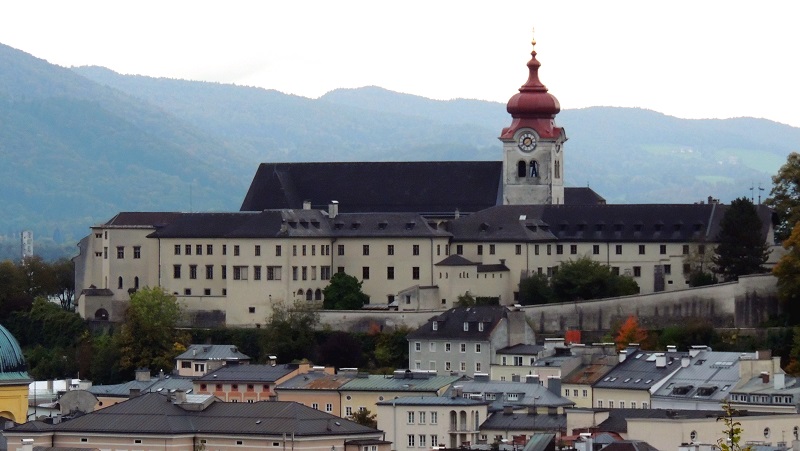
On the ridge Nonnberg near Hohensalzburg sits the Nonnberg Monastery, which was founded by St. Rupert around the year 712, and is thus the oldest nunnery in the German-speaking areas of the world. In this place was the fortification Castrum Superior in the Roman period.
Nonnberg Kloster is a Benedictine monastery, and its church was built 1464-1499 on the site of a former Romanesque church. The building was later expanded, and you can also see preserved parts of the former church, such as a portal.
Hellbrunn is a beautiful and very idyllic pleasure castle. It was Archbishop Markus Sittikus who had it built in 1612-1614 using the architect Santino Solari, who was associated with the court of Salzburg.
The function as a palace of pleasure must be taken literally, as Hellbrunn was built as a place of joie de vivre and optimism. An example is the castle’s famous water games, which were secret and suddenly jumping fountains that Markus Sittikus built to amuse his guests.
At Hellbrunn there is also an almost 400-year-old mechanical theatre, and in the castle park you can find exciting caves. The original quarry on the site was transformed into the open-air stage Stone Theatre/Steintheatre.
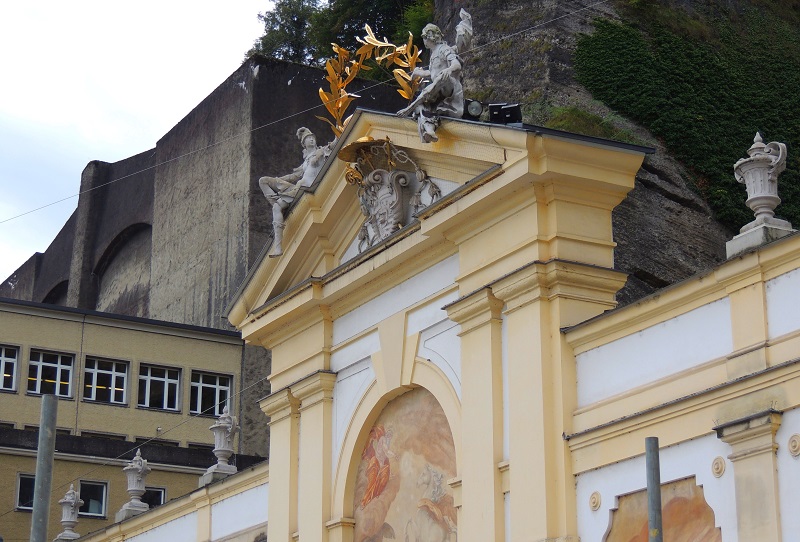
Pferdeschwemme was built as an elegant fountain, and it was also the place where the court’s horses were watered and cleaned on their way to the stables in the area.
Pferdeschwemme was built in 1695 by Johann Fischer von Erlach, with the exception of the large sculpture, which was done by Anton Pfaffinger in 1732. It depicts, among other things, the sea god Neptune, and horse motifs are painted around it on the walls.
From the Mönchsberg ridge there is a beautiful view of the baroque city centre, the river and the Hohensalzburg fortress. From Anton-Neumayr Platz, you can take an elevator to the observation deck at the top of Mönchsberg, where a branch of the Museum of Modern Art/Museum der Moderne is located.
In addition to the panoramic terrace facing the river Salzach and the museum, a trip to the Mönchsberg offers plenty of opportunities for hiking in green surroundings. Several paths start immediately behind the panoramic terrace, from which you can go to a preserved part of Salzburg’s old city wall.
The wall section is called the Bürgerwehr, and it is located with its towers about 100 meters south of the Museum der Moderne and thereby the panoramic terrace by the mountain’s elevator. The Bürgerwehr was laid out and built in the late 15th century as part of the city’s defense.
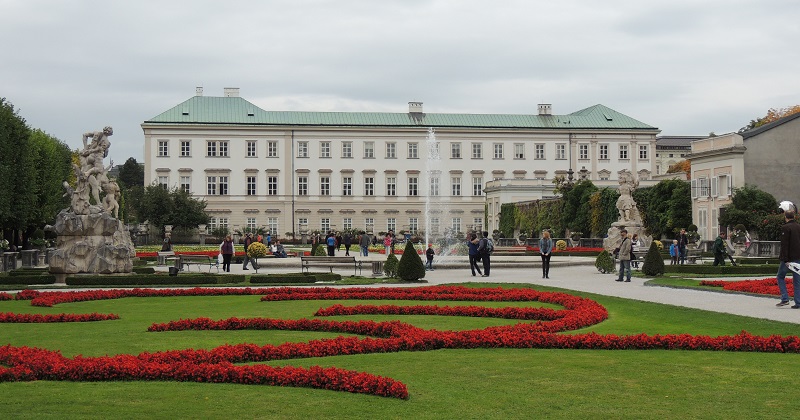
Mirabell Castle was built in 1606 by Archbishop Wolf Dietrich. He built the castle, which was outside what was then Salzburg, for his girlfriend and their 15 children in total. The subsequent Archbishop Markus Sittikus gave the castle, originally called Altenau, its current name.
In the 1720s, Archbishop Lukas von Hildebrandt had the castle rebuilt in fine baroque style. The castle burned down in 1818 and this time was partially rebuilt in the current classically inspired style. From Lukas von Hildebrandt’s castle you can today see the Marble Hall/Marmorsaal and the staircase with Georg Raphael Donner’s statues from 1726.
Mirabell Castle temporarily served as the summer palace of the Austrian emperors, while today it houses parts of the city’s administration, among other things.
Stiegl-Brauwelt is a journey of discovery through the secrets of the brewing of the local beer from the brewery Stiegl, whose history goes back to 1492. The exhibition is structured very nicely and with information about, among other things, beer culture and brewing techniques. Of course, there is also the opportunity to taste the products.
If you want to taste Stiegl in the city center of Salzburg, that can of course also be done. There are a lot of pubs here, and Stiegl-Keller (Festungsgasse 10) is a good choice.
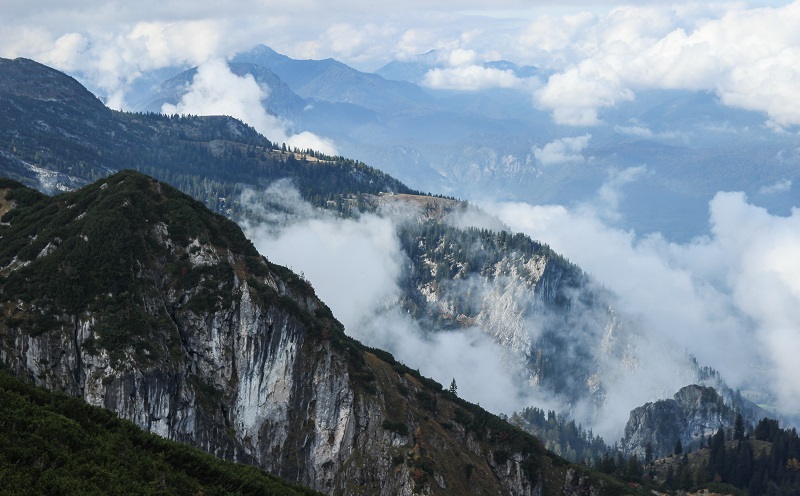
Untersberg massif is quite close to Salzburg, and a trip here is a good way to get to know the Alps. The highest point is the Berchtesgadener Hochthron, which reaches a height of 1,973 meters and is located in German Bavaria. Otherwise, the mountain lies and forms the border between Germany and Austria.
There are several hiking trails towards the heights of the Untersberg, and you can also take the Untersbergbahn cable car, which brings visitors up to the place Geiereck at an altitude of 1,805 meters. The cable car opened in 1961, and the ride up is particularly beautiful and exciting. From the top there is an incomparable view of the Salzburg region and to snow-capped mountain peaks.
Eisriesenwelt is a natural limestone cave and at the same time the world’s largest ice cave. The site is located in the Hochkogel mountain in the Austrian Alps, and the explored part counts approximately 42 kilometers of caves and passages. However, only the first kilometer is covered by the ice created by the river Salzach by eroding passages through the mountains. Here, snow could penetrate, and it is subsequently frozen into the ice world you can now experience.
Eisriesenwelt was officially explored for the first time in 1879, when Anton Posselt from Salzburg discovered and visited the outermost few hundred meters of the cave. Posselt’s publications were almost forgotten until Alexander von Mörk established several expeditions to the cave starting from 1912. Von Mörk died in 1914 and his ashes are in an urn in the Eisriesenwelt today.
Tourists started coming here in earnest from 1920, and visitor numbers really increased after 1955, when a new cable car cut part of the trip to the cave down from 90 minutes to just 3 minutes.
During a visit to the Eisriesenwelt, one is greeted by the very diverse and particularly fascinating formations of rocks and ice. Here there are caves of very different sizes and ice up to 25 meters high.
Eisriesenwelt is located at an altitude of 1,641 metres, and the trip up there is also very interesting. Part of the last stretch goes by cable car. For the visit, you should expect approximately three hours from and to the car park, and note that you have to walk a lot and up many steps and stairs. A total of 134 meters of height must be climbed.
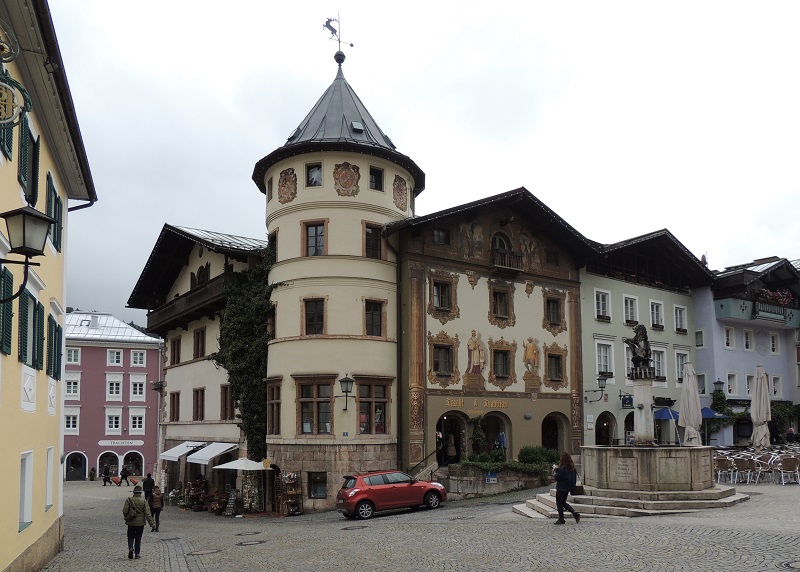
Down in the south-eastern corner of Germany lies the town of Berchtesgaden in nature’s butter-hole of the same name and surrounded by the Alps on three sides. The town itself is characterized by a cozy atmosphere with fine buildings within a short walking distance of each other, and the surrounding landscape is dominated by the area’s beautiful mountains.
Among the nicest and most interesting places in the city are the pedestrian streets around the Markt square and the buildings around the Castle Square/Schloßplatz. On the latter are both the Royal Palace/Königliche Schloß and Stiftkirken/Stiftskirche.
The castle’s history goes back to 1102, when a monastery was founded here. After various owners in the years following a secularization in 1803, the castle became royal from 1810, when it became the regents of the Kingdom of Bavaria. You can see beautiful halls such as the Great Dining Room/Großer Speisesaal on a tour of the castle. Stiftskirche was a monastery church during the royal palace’s time as a monastery. Its interior is very elegant.
The scenic Obersalzberg mountain area at Berchtesgaden is known for its beautiful nature and for Adolf Hitler’s love of the area, which led to the site being developed with a number of facilities after the Nazis came to power in 1933. Hitler had been coming here on holidays from 1923, and from In 1933 large parts of the area were cordoned off as the Führersperrgebiet.
Along with Adolf Hitler’s residence, many other houses and facilities were built on the Obersalzberg. For example, top politicians Hermann Göring, Albert Speer and Martin Bormann also had houses here, just as there were underground bunkers, an SS barracks and other facilities.
After World War II, Obersalzberg was under American control until 1996, when it returned to Bavaria and Germany, which three years later could open the Dokumentationszentrum Obersalzberg. However, after a massive British bombing on 25 April 1945 and subsequent blasts, not much remains of the Nazi facilities.
Among the remaining buildings are bunkers with access from the site’s documentation center, walls from the former luxury hotel Platterhof, located in the documentation center’s parking lot, and some retaining walls from Adolf Hitler’s Berghof complex. You can also stay at Hotel Zum Türken (Hintereck 2), which was Berghof’s neighbour. From the hotel there is direct access to part of Obersalzberg’s large bunker system.
This documentation center depicts parts of the history of the Third Reich. You can especially see the facilities in Obersalzberg described. In the area were residences and massive bunkers for the Third Reich’s high-ranking persons and military units. At Hotel Zum Türken (Hintereck 2) there is also access to parts of the facility.
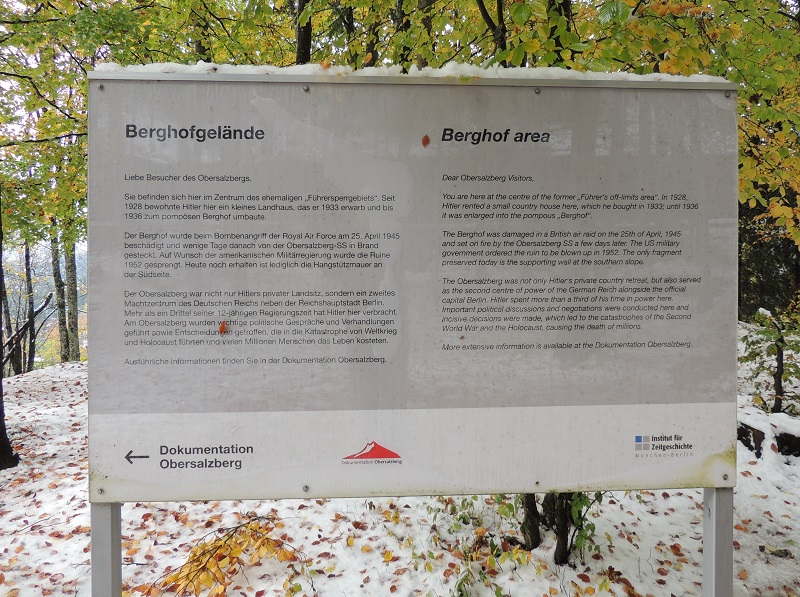
Berghof was the name of Adolf Hitler’s house in the southern German Berchtesgadener Land. The house was called Haus Wacherfeld when Hitler rented it from 1928. He bought it in 1933 and renamed it Berghof. From being a smaller house, the Berghof was expanded in the years 1933-1936 to be a large house that could be used both privately and for representation.
Hitler was often and for a long time in the Berghof, where he spent a total of about four years of his reign from 1933 to 1945. Thus, he often ruled Germany from here, and several state visits also took place here. Guests included British Prime Minister Neville Chamberlain and King Carol II of Romania.
On 25 April 1945, the Berghof and the entire area around the top Nazi facility here were bombed by the Royal Air Force, which dropped a total of around 1,300 bombs. In the years after World War II, a lot of movable property was stolen from the Berghof, which the Americans closed off access to in 1949. On April 30, 1952, Bavaria blew up the ruins of the Berghof and then left the place to nature.
Today, you can only see the remains of a retaining wall that was immediately behind the Berghof itself. In front of it, at the location of the Berghof, there is a sign indicating the location, which can be found by walking down a few hundred meters through the forest behind the Dokumentationszentrum Obersalzberg.
On the mountain Kehlstein at an altitude of 1,834 meters is the house Kehlsteinhaus, which was built in 1937-1938 as an official gift from the Nazi Party and thereby Germany to Adolf Hitler on his 50th birthday on April 20, 1939. The Kehlsteinhaus is literally on top of the mountain and also called Ørenreden/Adlerhorst. However, Hitler only visited the Kehlsteinhaus a few times and preferred his residence to the Berghof.
An event in the Kehlsteinhaus was a wedding on 3 June 1944. Here Eva Braun’s sister Gretl and Hermann Fegelein were married in the presence of, among others, Martin Bormann, who in his time initiated the construction of the house.
Access to the Kehlsteinhaus takes place from the Dokumentationszentrum Obersalzberg, from where you are taken by bus to the mountain and the elevator that takes you through the mountain 124 meters up to the house itself, which today is set up as a restaurant, and which of course also stands as a living museum with a formidable view.
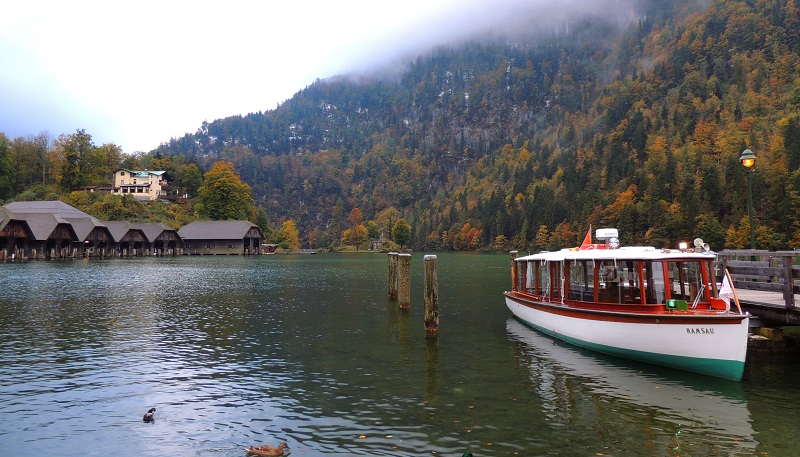
Königssee is like the center of nature, and according to many, the lake and its surroundings are the most beautiful place in Berchtesgaden. Königssee meanders between majestic mountains along its entire length. You can sail on the Königssee with tour boats, and on the western shore you can visit the excursion destination and the pilgrimage church of Sankt Bartholomä.
The area where you park from the north side and go to the boat trips has been built with a large selection of shops and restaurants for tourists, and here you can also see the former station building for the Königseebahn, which from 1909 connected the lake with Berchtesgaden.
Europastraße 1
europark.at
Südtirolerplatz 13
forum1.at
Rainerstraße 21
kiesel.at
Alpenstraße 107
shoppingcenter-alpenstrasse.at
Getreidegasse, Altstadt
Freilichtmuseum
Hasenweg, Grossgmain
freilichtmuseum.com
Haus der Natur
Museumplatz 5
hausdernatur.at
Spielzeug Museum
Bürgerspitalgasse 2
salzburgmuseum.at
Salzburg Zoo
Hellbrunn/Anif, 7 km S
salzburg-zoo.at
There have been settlements in the Salzburg area since the recent Stone Age, but it was not until the Hallstatt period that lasted between 1000-450 BC that a real permanent settlement was founded. It was not least due to large salt discoveries around Dürrnberg that led to a large trade.
Under Roman emperor Claudius, who ruled in the years 41-54, Juvavum, later Salzburg, received city rights. Juvavum was a modest Roman city that had military premises. After the fall of the Roman Empire, the city’s role was played out and it was effectively abandoned.
About 470 a monastery of St. Severin was founded, and in 696 St. Rupert came to the site and erected St. Peter’s Church. He renovated and expanded the city’s monastery, and St. Rupert is now considered the founder of the present Salzburg.
In the 7th century, Karl the Great Salzburg became the residence city of the Bavarian dukes, and after that status followed a bishop’s seat, and then the bishops ruled the city. Bishop Virgil had the city’s first cathedral erected, and with the city’s status and rapid development it became one of the largest in France.
Throughout the following centuries, Salzburg flourished, and in 1077 began the construction of the Hohensalzburg fortress, built on the site of the former Roman military camps.
With Frederick Barbarossa’s siege and burning of Salzburg in 1167, the city’s development slowed for a time. Salzburg was to be rebuilt and as part of the large-scale reconstruction plan, a new cathedral was erected.
In the 1200-1600s, several defense works were erected and continuously expanded. It was not least in the form of city walls that could ensure the consolidation and development of Salzburg, which flourished again after the destruction in 1167. Among other things, efforts were made to develop the city’s cultural life.
Salzburg were ruled by the archbishops with direct reference to the emperor. That status gave the city considerable powers to stimulate its own development, and as Salzburg maintained trade relations with the whole kingdom, it was a favorable position.
Throughout the 17th and 18th centuries, Salzburg gained much of its current unique Baroque appearance and atmosphere. It was Archbishop Wolf Dietrich von Raitenau who, at the beginning of the period, drew up a large-scale city plan for almost a whole new city.
Subsequently, other archbishops, primarily Markus Sittikus von Hohenems and Paris Lodron, completed Wolf Dietrich’s plan. Hundreds of churches, palaces and mansions date from this time.
In 1756, Salzburg’s most famous urban child was born. Later composer Wolfgang Amadeus Mozart came to the world in the central city and you can still visit his birthplace in Getreidegasse. In 1842, the city of Mozart commemorated the erection of a monument in his memory at the newly named Mozart Square.
In connection with the Napoleonic Wars, Salzburg’s status as its own diocese ceased. The city became part of Austria’s Habsburgs in 1816, and with it the political power was moved to Vienna. Two years later, in 1818, much of Salzburg was destroyed by a fire, and once again a reconstruction work had to be completed.
Culturally, these years, painters of the romantic school are taking an interest in Salzburg’s special atmosphere, and the city is once again a gathering place for many artists. Musically, the world-renowned and popular Christmas song Happy Christmas is played for the first time in Salzburg’s St. Nicholas Church.
In 1920, the first of the annual recurring party games were organized, whose performances are one of the city’s and the world’s leading cultural events within its kind. Over the years, many of the masters of music have contributed to the festival, not least Herbert von Karajan, who founded the Easter Festival in 1967.
During World War II, Salzburg was exposed to aerial bombardments in 1944-1945. The city was quickly rebuilt and it developed into one of Austria’s leading trading centers in the years after World War II.
In recent decades, Salzburg’s cultural life has flourished once again. The expansion with several festival halls was completed in 1960, and in 1964 the film Sound of Music was recorded in the city, which still attracts many travelers who want to experience the film’s locations and atmosphere.
Salzburg is Austria’s regional political and economic center, and a number of impressive modern buildings have been erected in recent decades to complement the unique Baroque city of Mozart’s time.
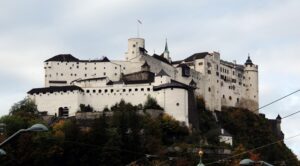
Salzburg, Austria
Overview of Salzburg
Salzburg is one of the Baroque architectural gems of the world, and as a traveler you can almost hear Mozart’s fantastic compositions in the streets. Everywhere in the old town you will be greeted by breathtaking buildings that clearly showcase the wealth the city has maintained throughout history.
The archbishops lived here and built impressive churches, fine castles and elegant squares, and as the top of everything, they laid out prestigious parks and built many sculptures to beautify the city. All this remains today, and with the city’s surroundings hills, you can easily enjoy Salzburg’s elegant skyline from several vantage points.
Salzburg is, for many, the equivalent of classical music and other culture, and as Mozart’s birthplace it do has a lot to offer. It all culminates with the world-famous festivals that are recurring events. At the festivities the city stands in the sign of music, and also at other times of the year you can enjoy church concerts and so on.
About the Whitehorse travel guide
Contents: Tours in the city + tours in the surrounding area
Published: Released soon
Author: Stig Albeck
Publisher: Vamados.com
Language: English
About the travel guide
The Whitehorse travel guide gives you an overview of the sights and activities of the Canadian city. Read about top sights and other sights, and get a tour guide with tour suggestions and detailed descriptions of all the city’s most important churches, monuments, mansions, museums, etc.
Whitehorse is waiting for you, and at vamados.com you can also find cheap flights and great deals on hotels for your trip. You just select your travel dates and then you get flight and accommodation suggestions in and around the city.
Read more about Whitehorse and Canada
Canada Travel Guide: https://vamados.com/canada
City tourism: https://visitwhite-horse.ca
Main Page: https://www.vamados.com/
Buy the travel guide
Click the “Add to Cart” button to purchase the travel guide. After that you will come to the payment, where you enter the purchase and payment information. Upon payment of the travel guide, you will immediately receive a receipt with a link to download your purchase. You can download the travel guide immediately or use the download link in the email later.
Use the travel guide
When you buy the travel guide to Whitehorse you get the book online so you can have it on your phone, tablet or computer – and of course you can choose to print it. Use the maps and tour suggestions and you will have a good and content-rich journey.


Salzburg’s distinguished Residenzplatz was created by Archbishop Wolf Dietrich from 1587. Here began the demolition of the city’s Domkirkekloster/Domkloster and 55 residential houses in the then Pfeifergasse. On the same occasion, the cathedral’s cemetery was cleared, and with that activity, space was really created for Salzburg’s transition from a medieval city to an elegant and princely residence.
On the Residenzplatz you can see the sumptuous fountain Residenzbrunnen, which was made in Baroque style 1656-1661 by Tomasso di Garona. The material is white marble that comes from the nearby Untersberg.
Around the Residenzplatz lies the side of the cathedral Salzburger Dom and the city’s two large residences; Residenz and Neue Residenz. A detail facing the square of the Neue Residenz is the tower’s carillon, the Glockenspiel, built with 35 bells from Antwerp in 1702. It plays at several times daily.
Incidentally, the only book burning took place on Residenzplatz following the German-Nazi model in the former Austria, which in 1938 became part of Germany. It took place on April 30, 1938.
The Neue Residenz is a beautiful building designed like a cornucopia of a museum. There are many different themes in the beautiful rooms and halls. 19th-century romantic painters’ impressions of the Salzburg region, archaeological finds from several millennia, great personalities from the city and remains of Roman houses are just some of the things you can choose to see.
The Neue Residenz building itself was built by the prince-bishop Wolf Dietrich von Raitenau from the year 1588. The elegant construction was intended as a residence for the bishop’s brother, but instead it became the setting for various public functions and events.
The decoration of the Neue Residenz was planned as more detailed than the result, which, despite other plans, turned out to be a beautiful whole with the castle tower as one of the crowns of the work. The top of the tower with an octagonal floor and a lantern dates from 1701-1702, when Archbishop Johann Ernst von Thun installed the residence’s fine and famous carillon, consisting of 35 bells from Antwerp.
Other decorations include a coat of arms in each corner. They come from the families of Wolf Dietrich von Raitenau’s grandparents; Hohenems, Medici, Raitenau and Sirgenstien.
Mozartplatz is one of the central squares in Salzburg’s baroque center. It was laid out in its original form in 1588 under Wolf Dietrich von Raitenau as part of the representative road to the city center. In 1620, Paris gave Lodron the building sites on the east side of Mozartplatz, which could then be completed according to plan.
Mozartplatz is dominated by the fine memorial statue of the composer Wolfgang Amadeus Mozart, who was born in the city on January 27, 1756. The statue was made by Ludwig von Schwanthaler, and it was inaugurated in 1842 with the participation of, among others, Mozart’s two sons; Carl Thomas and Franz Xaver. The monument had come into being after a major donation by King Ludwig I of Bavaria, and during its construction a Roman mosaic was found.
Buildings around the square include the Neue Residenz (Mozartplatz 1), the former noble residence of the von Rehlingen family, the Antretter Haus (Mozartplatz 4), Das Imhofstöckl (Mozartplatz 5-7) from around 1620 and the three palatial properties Kanonicalhöfe (Mozartplatz 8-10) , which were built as residences with integrated facades in the 17th century.

On the ridge Nonnberg near Hohensalzburg sits the Nonnberg Monastery, which was founded by St. Rupert around the year 712, and is thus the oldest nunnery in the German-speaking areas of the world. In this place was the fortification Castrum Superior in the Roman period.
Nonnberg Kloster is a Benedictine monastery, and its church was built 1464-1499 on the site of a former Romanesque church. The building was later expanded, and you can also see preserved parts of the former church, such as a portal.
Hellbrunn is a beautiful and very idyllic pleasure castle. It was Archbishop Markus Sittikus who had it built in 1612-1614 using the architect Santino Solari, who was associated with the court of Salzburg.
The function as a palace of pleasure must be taken literally, as Hellbrunn was built as a place of joie de vivre and optimism. An example is the castle’s famous water games, which were secret and suddenly jumping fountains that Markus Sittikus built to amuse his guests.
At Hellbrunn there is also an almost 400-year-old mechanical theatre, and in the castle park you can find exciting caves. The original quarry on the site was transformed into the open-air stage Stone Theatre/Steintheatre.

Pferdeschwemme was built as an elegant fountain, and it was also the place where the court’s horses were watered and cleaned on their way to the stables in the area.
Pferdeschwemme was built in 1695 by Johann Fischer von Erlach, with the exception of the large sculpture, which was done by Anton Pfaffinger in 1732. It depicts, among other things, the sea god Neptune, and horse motifs are painted around it on the walls.
From the Mönchsberg ridge there is a beautiful view of the baroque city centre, the river and the Hohensalzburg fortress. From Anton-Neumayr Platz, you can take an elevator to the observation deck at the top of Mönchsberg, where a branch of the Museum of Modern Art/Museum der Moderne is located.
In addition to the panoramic terrace facing the river Salzach and the museum, a trip to the Mönchsberg offers plenty of opportunities for hiking in green surroundings. Several paths start immediately behind the panoramic terrace, from which you can go to a preserved part of Salzburg’s old city wall.
The wall section is called the Bürgerwehr, and it is located with its towers about 100 meters south of the Museum der Moderne and thereby the panoramic terrace by the mountain’s elevator. The Bürgerwehr was laid out and built in the late 15th century as part of the city’s defense.

Mirabell Castle was built in 1606 by Archbishop Wolf Dietrich. He built the castle, which was outside what was then Salzburg, for his girlfriend and their 15 children in total. The subsequent Archbishop Markus Sittikus gave the castle, originally called Altenau, its current name.
In the 1720s, Archbishop Lukas von Hildebrandt had the castle rebuilt in fine baroque style. The castle burned down in 1818 and this time was partially rebuilt in the current classically inspired style. From Lukas von Hildebrandt’s castle you can today see the Marble Hall/Marmorsaal and the staircase with Georg Raphael Donner’s statues from 1726.
Mirabell Castle temporarily served as the summer palace of the Austrian emperors, while today it houses parts of the city’s administration, among other things.
Stiegl-Brauwelt is a journey of discovery through the secrets of the brewing of the local beer from the brewery Stiegl, whose history goes back to 1492. The exhibition is structured very nicely and with information about, among other things, beer culture and brewing techniques. Of course, there is also the opportunity to taste the products.
If you want to taste Stiegl in the city center of Salzburg, that can of course also be done. There are a lot of pubs here, and Stiegl-Keller (Festungsgasse 10) is a good choice.
Similar to Salzburg Travel Guide
